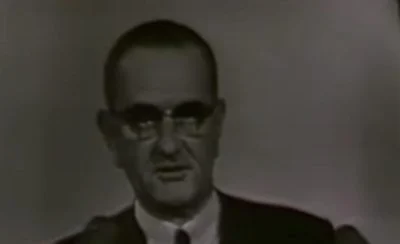From the Gulf of Tonkin to the Baltic Sea
ANGLO AMERICA, 6 Mar 2023
Seymour M. Hersh | Global Research – TRANSCEND Media Service
The secret and incomplete history of US-Norway collaboration in covert operations.

Lyndon B. Johnson delivering his televised report on the Gulf of Tonkin incident, August 4, 1964. (Source: Seymour Hersh)
22 Feb 2023 – Why Norway? In my account of the Biden Administration’s decision to destroy the Nord Stream pipelines, why did much of the secret planning and training for the operation take place in Norway? And why were highly skilled seamen and technicians from the Norwegian Navy involved?
The simple answer is that the Norwegian Navy has a long and murky history of cooperation with American intelligence. Five months ago that teamwork—about which we still know very little—resulted in the destruction of two pipelines, on orders of President Biden, with international implications yet to be determined. And six decades ago, so the histories of those years have it, a small group of Norwegian seamen were entangled in a presidential deceit that led to an early—and bloody—turning point in the Vietnam war.
After the Second World War, ever prudent Norway invested heavily in the construction of large, heavily armed fast attack boats to defend its 1,400 miles of Atlantic Ocean coastline. These vessels were far more effective than the famed American PT boat that was ennobled in many a postwar movie. These boats were known as “Nasty-class,” for their powerful gunnery, and some of them were sold to the US Navy. According to reporting in Norway, by early 1964 at least two Norwegian sailors confessed to their involvement in CIA-led clandestine attacks along the North Vietnam coast. Other reports, never confirmed, said the Norwegian patrol boats where manned by Norwegian officers and crew. What was not in dispute was that the American goal was to put pressure on the leadership in North Vietnam to lessen its support of the anti-American guerrillas in South Vietnam. The strategy did not work.
None of this was known at the time to the American public. And the Norwegians would keep the secret for decades. The CIA’s lethal game of cat-and-mouse warfare led to a failed attack on August 2, 1964, with three North Vietnamese gunships engaging two American destroyers—the USS Maddox and the USS Turner Joy—on a large body of contested water known as the Gulf of Tonkin that straddled both North and South Vietnam.
Two days later, with the destroyers still intact, the commander of the Maddox cabled his superiors that he was under a torpedo attack. It was a false alarm, and he soon rescinded the report. But the American signals intelligence community—under pressure from Secretary of Defense Robert McNamara, who was doing President Johnson’s bidding—looked the other way as McNamara ignored the second cableand Johnson told the American public there was evidence that North Vietnam had attacked an American destroyer. Johnson and McNamara had found a way to take the war to North Vietnam.
Johnson’s nationally televised speech on the evening of August 4, 1964, is chilling in its mendacity, especially when one knows what was to come.
“This new act of aggression,” he said, “aimed directly at our own forces, again brings home to all of us in the United States the importance of the struggle for peace and security in Southeast Asia. Aggression by terror against the peaceful villagers of South Vietnam has now been joined by open aggression on the high seas against the United States of America.”
Public anger swelled, and Johnson authorized the first American bombing of the North. A few days later Congress passed the Tonkin Gulf Resolution with only two dissenting votes, giving the president the right to deploy American troops and use military force in South Vietnam in any manner he chose. And so it went on for the next eleven years, with 58,000 American deaths and millions of Vietnamese deaths to come.
The Norwegian navy, as loyal allies in the Cold War, stayed mum, and over the next few years, according to further reporting in Norway, sold eighteen more of their Nasty Class patrol boats to the U.S. Navy. Six were destroyed in combat.
In 2001, Robert J. Hanyok, a historian at the National Security Agency, published Skunks, Bogies, Silent Hounds, and the Flying Fish: The Gulf of Tonkin Mystery, 2–4 August 1964,a definitive study of the events in the gulf, including the manipulation of signals intelligence. He revealed that 90 percent of the relevant intercepts, including those from the North Vietnamese, had been kept out the NSA’s final reports on the encounter and thus were not provided to the Congressional committees that later investigated the abuse that led America deeper into the Vietnam War.
That is the public record as it stands. But, as I have learned from a source in the US intelligence community, there is much more to know. The first batch of Norwegian patrol boats meant for the CIA’s undeclared war against the North Vietnamese actually numbered six. They landed in early 1964 at a Vietnamese naval base in Danang, eighty-five miles south of the border between North and South Vietnam. The ships had Norwegian crews and Norwegian Navy officers as their captains. The declared mission was to teach American and Vietnamese sailors how to operate the ships. The vessels were under the control of a long-running CIA-directed series of attacks against coastal targets inside North Vietnam. The secret operation was controlled by the Joint Chiefs of Staff in Washington and not by the American command in Saigon, which was then headed by Army General William Westmoreland. That shift was deemed essential because there was another aspect of the undeclared war against the North that was sacrosanct. US Navy SEALs were assigned to the mission with a high-priority list of far more aggressive targets that included heavily defended North Vietnamese radar facilities.
It was a secret war within a secret war. I was told that at least two SEALs were ambushed by the North Vietnamese and severely wounded in a fire fight. Both men managed to make their way to the coast and were eventually rescued. Both men were awarded the Medal of Honor, America’s highest decoration, in secret.
There also were far less dramatic movements as the war unraveled. At some later date, it was decided to arm bats with incendiary devices and drop them, by air, over areas of high interest in the south. The release came at high altitude, and the bats quickly froze to death.
This bit of top secret and heretofore unknown history raises, to this reporter, an obvious question: what else do we not know about the secret operation in Norway that led to the destruction of the pipelines? And is there anyone in the Senate and the House, or in the American press, interested in finding out what was going on—and what else we do not know?
_____________________________________________
 Seymour M. Hersh’s investigative journalism and publishing awards include one Pulitzer Prize, five George Polk Awards, two National Magazine Awards, and more than a dozen other prizes for investigative reporting. Hersh won a National Magazine Award for Public Interest for his 2003 articles “Lunch with the Chairman,” “Selective Intelligence,” and “The Stovepipe.” In 2004 he exposed the Abu Ghraib prison scandal in a series of pieces; in 2005, he again received a National Magazine Award for Public Interest, an Overseas Press Club award, the National Press Foundation’s Kiplinger Distinguished Contributions to Journalism award, and his fifth George Polk Award, making him that award’s most honored laureate. He lives in Washington DC.
Seymour M. Hersh’s investigative journalism and publishing awards include one Pulitzer Prize, five George Polk Awards, two National Magazine Awards, and more than a dozen other prizes for investigative reporting. Hersh won a National Magazine Award for Public Interest for his 2003 articles “Lunch with the Chairman,” “Selective Intelligence,” and “The Stovepipe.” In 2004 he exposed the Abu Ghraib prison scandal in a series of pieces; in 2005, he again received a National Magazine Award for Public Interest, an Overseas Press Club award, the National Press Foundation’s Kiplinger Distinguished Contributions to Journalism award, and his fifth George Polk Award, making him that award’s most honored laureate. He lives in Washington DC.
Go to Original – globalresearch.ca
Tags: Corruption, Eastern Europe, Energy, European Union, Gas, Hegemony, Imperialism, Military Industrial Media Complex, Multipolar World Order, NATO, Nordstream 2, Nuclear war, Pentagon, Proxy War, Putin, Russia, Seymour Hersh, State Terrorism, US Military, US empire, USA, Ukraine, War Economy, Warfare, West
DISCLAIMER: The statements, views and opinions expressed in pieces republished here are solely those of the authors and do not necessarily represent those of TMS. In accordance with title 17 U.S.C. section 107, this material is distributed without profit to those who have expressed a prior interest in receiving the included information for research and educational purposes. TMS has no affiliation whatsoever with the originator of this article nor is TMS endorsed or sponsored by the originator. “GO TO ORIGINAL” links are provided as a convenience to our readers and allow for verification of authenticity. However, as originating pages are often updated by their originating host sites, the versions posted may not match the versions our readers view when clicking the “GO TO ORIGINAL” links. This site contains copyrighted material the use of which has not always been specifically authorized by the copyright owner. We are making such material available in our efforts to advance understanding of environmental, political, human rights, economic, democracy, scientific, and social justice issues, etc. We believe this constitutes a ‘fair use’ of any such copyrighted material as provided for in section 107 of the US Copyright Law. In accordance with Title 17 U.S.C. Section 107, the material on this site is distributed without profit to those who have expressed a prior interest in receiving the included information for research and educational purposes. For more information go to: http://www.law.cornell.edu/uscode/17/107.shtml. If you wish to use copyrighted material from this site for purposes of your own that go beyond ‘fair use’, you must obtain permission from the copyright owner.